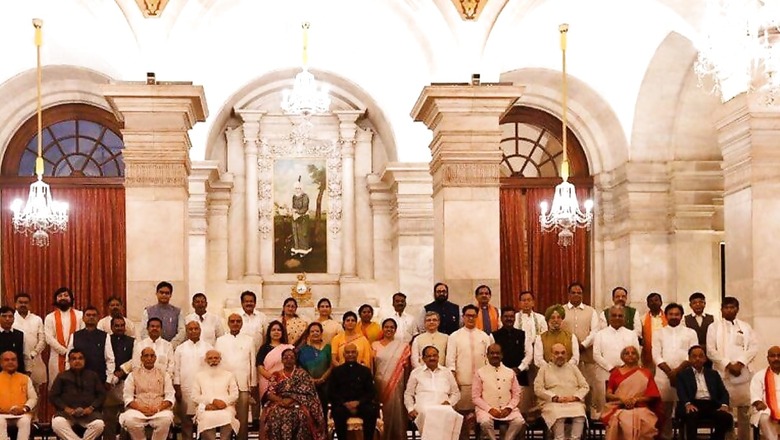
views
A Cabinet reshuffle is geared towards three objectives: enhance representation, pacify or punish, and enable better governance. The first, ‘big and bold’ reshuffle in Prime Minister Narendra Modi’s second term is a rare instance of all three being prima facie effectuated.
The Goddess of Diversity has been appeased, with 11 women, 27 OBCs, 12 members of the Scheduled Castes and eight of the Scheduled Tribes in the most inclusive council of ministers so far. The ‘rainbow’ effect is a bit tarnished by the fact that the Union Cabinet still boasts of just two women, as opposed to six in the first Modi ministry.
Ticking All the Boxes
The exercise was predictably Uttar Pradesh-centric. In the election-bound state, the BJP must cater to interest groups and so, another seven ministers have been added to the ten – including Modi – who are already in the council of ministers. Besides, Hardeep Singh Puri, who represents UP in the Rajya Sabha, has been promoted and given the key Petroleum portfolio.
In terms of regional representation, not all points of the compass were accommodated, but the focus was clearly on the South, with new faces from Karnataka (four) and Tamil Nadu (one); the West, with inductees from Maharashtra (four) and Gujarat (three) and the East, featuring Odisha (two), West Bengal (four) and the North-East (three).
As for caste, Modi has carried forward the BJP’s pro-OBC approach. So, regional, caste and gender identities have been kept in mind, as well as the age demographic and skillsets. Doctors, engineers, ex-civil servants and lawyers figure in the new team, bringing a fresh infusion of skillsets.
Ashwini Vaishnaw, IIT-ian, MBA and former IAS officer, has been given the challenging portfolios of Railways, Communications and IT. The media-friendly Anurag Thakur is the new Information & Broadcasting minister. Mansukh Mandaviya has no academic background in health, but his vigorous involvement in the ‘Jan Aushadhi’ campaign may have clinched the portfolio for him.
It was important to give the allies a place in the sun, given the recent erosion of the NDA; accordingly, the JD(U) and the LJP (Paras) were granted Cabinet berths while the Apna Dal was given MoS status.
Equally necessary was the promotion of newcomers, hence Cabinet berths for Jyotiraditya Scindia and Narayan Rane and MoS status for Kapil Moreshwar Patil, so as to send positive signals to future entrants. Sarbananda Sonowal was another must-have, given his successful term in Assam and his peaceful exit as chief minister. The message being that merit and discipline will be acknowledged.
Pacify or Punish
The second objective of the reshuffle usually has to do with being seen to reward performance and enforce accountability. Those who don’t measure up or have been in the saddle too long are shown the door, along with some who have to make way for fresh faces. However, personal likes and dislikes, lobbying by regional satraps and pacifying rebellious individuals tend to play a role.
The second wave of COVID-19 felled erstwhile health minister Harsh Vardhan, while the BJP’s poor performance in the West Bengal Assembly elections may have cost Babul Supriyo and Debasree Chaudhuri their berths. Santosh Gangwar blotted his copybook by critiquing the UP government’s handling of the pandemic.
Prakash Javadekar and Ravi Shankar Prasad, erstwhile Information & Broadcasting and IT ministers respectively, may have paid the price for the bad press and adverse social media campaigns the Indian government has faced in recent years, although a more charitable view of their exit could be that they will be more useful in the party. Ramesh Pokhriyal ‘Nishank’ likewise retired hurt, while Thawar Chand Gehlot made an honorable exit as governor of Karnataka.
The timing of the reshuffle is curious, in that the Parliament session is around the corner, giving the new ministers very little time to prepare for the Opposition’s onslaught. Another intriguing decision is the setting up of a Ministry of Cooperation under Home Minister Amit Shah, which does not signal minimum governance. A notable omission in the exercise is the absence of a member of the dominant minority community. Punjab and the erstwhile Jammu & Kashmir, too, are missing.
Need Proactive Ministers
The third objective of the exercise is to improve governance. The strength of the council of ministers has increased by 25, a positive step, as the practice of one minister handling several portfolios is clearly impractical. Prasad and Javadekar had three each, as do Piyush Goyal and Pralhad Joshi.
However, boosting the number of warm bodies available won’t help, unless ministers become more proactive. The PMO is seen as meddlesome and intrusive, undercutting ministers and keeping files pending. Ministers, on the other hand, have been ultra-cautious, referring routine matters to the PMO and seeking advice at the drop of a hat, so afraid are they of incurring the PM’s wrath. What’s needed is an injection of character and a more hands-off approach by the PMO.
Overall, the reshuffle comes across as governance-oriented and replete with political signalling.
Read all the Latest News, Breaking News and Coronavirus News here.




















Comments
0 comment